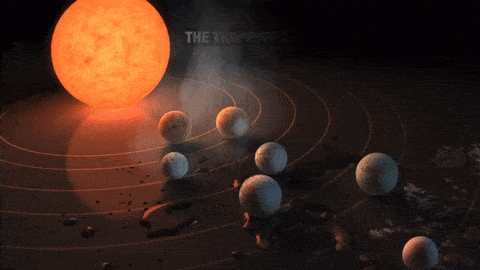
Foundations Of Astronomy
Quiz
•
Science
•
8th - 12th Grade
•
Practice Problem
•
Hard
+1
Standards-aligned

Clint Sandford
Used 1K+ times
FREE Resource
Enhance your content in a minute
20 questions
Show all answers
1.
MULTIPLE CHOICE QUESTION
30 sec • 1 pt

From the choices presented - which is the largest object or structure in space?
Earth
The Sun
The Solar System
The asteroid belt
Tags
NGSS.MS-ESS1-3
2.
MULTIPLE CHOICE QUESTION
30 sec • 1 pt

Which object or structure is the smallest?
Earth
Mars
Jupiter
The Solar System
Tags
NGSS.MS-ESS1-3
3.
MULTIPLE CHOICE QUESTION
30 sec • 1 pt

The largest single object in the solar system is ______.
Saturn
Jupiter
Earth
The Sun
Tags
NGSS.MS-ESS1-3
4.
MULTIPLE CHOICE QUESTION
45 sec • 1 pt

The largest structure in the entire Universe is the
Universe itself.
Orion Nebula.
Milky Way Galaxy.
Virgo Supercluster.
5.
MULTIPLE SELECT QUESTION
1 min • 1 pt

What is a "light year?"
a distance of about 6 trillion miles (9.8 trillion km)
the distance traveled by the speed of light in 1 year
the time traveled by the speed of light in 1 year
a distance of about 6 billion miles (9.8 billion km)
Tags
NGSS.MS-ESS1-3
6.
MULTIPLE SELECT QUESTION
1 min • 1 pt

Why do astronomers use light years as a measurement?
because miles & kilometers are sufficient
it's an easier way to describe huge distances
it's an easier way to describe large objects such as stars
because distances in space are extremely vast
Tags
NGSS.MS-ESS1-3
7.
MULTIPLE CHOICE QUESTION
30 sec • 1 pt

The Milky Way galaxy is approximately _____ thousand light years in diameter.
1000
10
100
1
Tags
NGSS.MS-ESS1-3
Create a free account and access millions of resources
Create resources
Host any resource
Get auto-graded reports

Continue with Google

Continue with Email

Continue with Classlink

Continue with Clever
or continue with

Microsoft
%20(1).png)
Apple
Others
By signing up, you agree to our Terms of Service & Privacy Policy
Already have an account?
Similar Resources on Wayground

15 questions
Synthetic fibers and plastics
Quiz
•
8th Grade

20 questions
ELS 11 Quiz 2.1 Geological Time Scale
Quiz
•
11th Grade

17 questions
(2.4) Isotopes and Its Uses
Quiz
•
10th Grade

15 questions
Electricity
Quiz
•
7th - 9th Grade

16 questions
English articles
Quiz
•
9th - 12th Grade

20 questions
Geological and Hydrometeorological Hazards
Quiz
•
12th Grade

20 questions
Genetics Vocab
Quiz
•
8th Grade

15 questions
Earth History Investigation 3 Deposition
Quiz
•
7th - 8th Grade
Popular Resources on Wayground

10 questions
Honoring the Significance of Veterans Day
Interactive video
•
6th - 10th Grade

9 questions
FOREST Community of Caring
Lesson
•
1st - 5th Grade

10 questions
Exploring Veterans Day: Facts and Celebrations for Kids
Interactive video
•
6th - 10th Grade

19 questions
Veterans Day
Quiz
•
5th Grade

14 questions
General Technology Use Quiz
Quiz
•
8th Grade

25 questions
Multiplication Facts
Quiz
•
5th Grade

15 questions
Circuits, Light Energy, and Forces
Quiz
•
5th Grade

19 questions
Thanksgiving Trivia
Quiz
•
6th Grade
Discover more resources for Science

20 questions
Physical and Chemical Changes
Quiz
•
8th Grade

10 questions
Exploring Newton's Laws of Motion
Interactive video
•
6th - 10th Grade

20 questions
Balanced and Unbalanced Forces
Quiz
•
6th - 8th Grade

20 questions
Galaxies
Quiz
•
8th Grade

22 questions
Plate Tectonics
Lesson
•
6th - 8th Grade

10 questions
Unit 2: LS.Bio.1.5-LS.Bio.2.2 Power Vocab
Quiz
•
9th - 12th Grade

9 questions
Conduction, Convection, and Radiation
Lesson
•
6th - 8th Grade

20 questions
Life Cycle of a Star
Quiz
•
8th Grade



